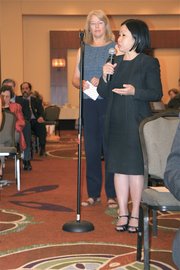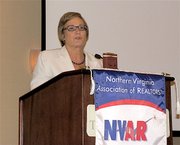Moderator Kenneth R. Harney anchors the podium and questions panelists Jamie Gregory, Dr. Michael Fratantoni, and Dr. Stephen Fuller. Photo by Andrea Worker
The Northern Virginia Association of Realtors (NVAR), in partnership with the George Mason University Center for Regional Analysis hosted their Annual Economic Summit at the Mason Inn Conference Center. The housing market is a key driver of the economy and home ownership is almost synonymous with the “American Dream,” so it’s no wonder that this year’s distinguished panel played to a packed house of realtors, brokers, economists and area business people.
To date, Northern Virginia has experienced less of the unemployment and home foreclosure traumas that have plagued other parts of the country. The area continues to be the place where most domestic migration occurs. More people move in—and out—of Northern Virginia and the D.C. Metropolitan area than anywhere else in the country, a fact that leads to a busy, but often confusing, housing market. The conferees gathered in the Mason Inn Ballroom were there to determine if recent positive trends would continue and to gain a heads-up as to what issues of importance may be lurking just around the bend.
THE SPEAKERS included Carol J. Galante, the Acting FHA commissioner and asst. secretary, U.S. Dept. of Housing & Urban Development; Jamie Gregory, the deputy chief lobbyist for the NVAR; Dr. Michael Fratantoni, vice president, Single-Family Research & Policy Development, Mortgage Bankers Association; and Dr. Stephen Fuller, the Director, Center for Regional Analysis at George Mason University. Together, they possess an impressive collection of educational credentials, public and private sector experiences and appointments, as well as a catalogue of published materials.
The Washington Post “The Nation’s Housing” nationally syndicated columnist Kenneth R. Harney moderated the discussion.
There was good news. Statistics supported the positive trends being felt in the area markets. A 7.89 percent increase in home sales in 2012 vs. 2011 YTD. A 21.43 percent decrease in the average days on the market for the same time period. Several of the panelists presented documentation showing that housing prices in close-in communities like Alexandria and Arlington have returned to near pre-bubble burst levels, while other areas are seeing a more modest, but welcome increase. “There is a shift in buyers’ psychology,” said Dr. Fratantoni. “More optimism.”
One factor driving the higher prices and lesser selling times is the supply crunch. The relatively low unemployment rate in the area, the higher-income profile of many Northern Virginian workers, and the slowdown in new home construction have all contributed to the imbalance between supply and demand. An NVAR Home Sales report from August 2012 listed the housing supply as being down by 33.83 percent compared to last year, equating to only about a two-month supply. Virginia’s better-than-average performance in the housing industry can also thank the state’s guidelines on foreclosure proceedings, which are slower and more measured than many others, including Maryland and the District of Columbia.
The presentation by Carol Galante was met by applause on several occasions, particularly when she spoke of new guidance taking immediate temporary effect that would aid in the purchase of condominiums, putting in place an exemptions process to address what many believed to be overly strict regulations regarding the ratio of commercial space to a condominium project. Galante also assured the crowd that the FHA was “mindful of credit overlay. We are working with our partners to help lenders and see if they can loosen up a bit.… and we are looking at ways to make short sales easier.”
THE TOPIC of rentals versus home sales sparked interest in the crowd. In an uncertain economy, rentals have been understandably on the rise. There was also agreement among the speakers that the newest generation to enter the workforce is not as motivated to buy as previous generations. “When we were coming up,” said Dr. Fuller, “buying your own home was a motivator. Today’s young workers don’t see it that way. They don’t necessarily see housing as a good investment. They also seem to like the flexibility of renting.” The general conclusion of the panel was that many renters would ultimately become homeowners, but that the gap between renting and owning would be a longer one and require adjustment by the industry.
Despite a generally positive outlook, the panelists addressed a number of serious speed bumps on the immediate horizon, not the least of which being the federal budget “fiscal cliff” looming in January 2013. Known as sequestration, the “cliff” refers to the massive tax increases and federal spending cuts that will be mandated unless Congress acts quickly. As the NVAR Deputy Chief Lobbyist Jamie Gregory pointed out, “Not much will be happening until after the election, during the lame duck session. And there is so much that needs to be addressed. Expiring Bush era tax cuts, payroll tax cuts, the 2007 mortgage cancellation that expires on Dec. 31, the debt ceiling.” Gregory also noted that getting things done on these issues in Congress is further hampered by the lack of institutional knowledge among its members. “Since 2006,” he said, “50 percent of the Congress are freshmen. And if projections are correct that the upcoming elections may yield no clear majority, that makes it even harder to get things accomplished.”
Dr. Fratantoni reminded the audience that job creation and stability were still the cornerstones of a healthy housing market. Northern Virginia can currently boast some of the best employment-related figures in the nation. If sequestration is not avoided, however, the consequences for Virginia could be dire. In a July 2012 report, panelist Dr. Stephen Fuller concluded that Virginia could account for nearly 10 percent of the estimated 2.14 million jobs that could be lost.
The first question from the floor during the Q&A brought a laugh from the audience, but a serious response from moderator Kenneth Harney. The question? Which party in the White House would mean the faster recovery. Harney’s reply? Both parties “were ignoring the elephant in the room. Housing didn’t even get a mention at either of the conventions, and yet, the health of housing and real estate is essential to the economic health of the country.”
Deputy Chief Lobbyist Gregory added, “The action, or the inaction, will be in Congress, not the White House,” but he assured the assembly that the NVAR would certainly do everything in its power to aid in a detour away from the cliff, allowing the Northern Virginia housing market to continue along its slow, yet steady path of recovery.






